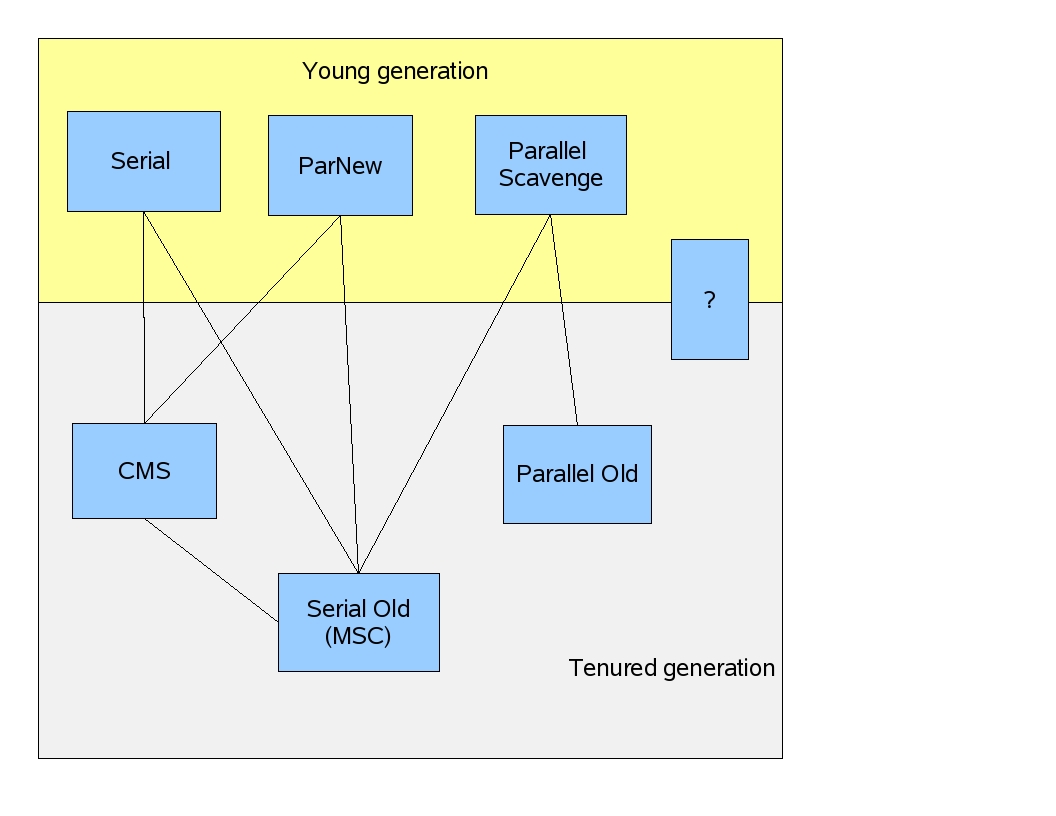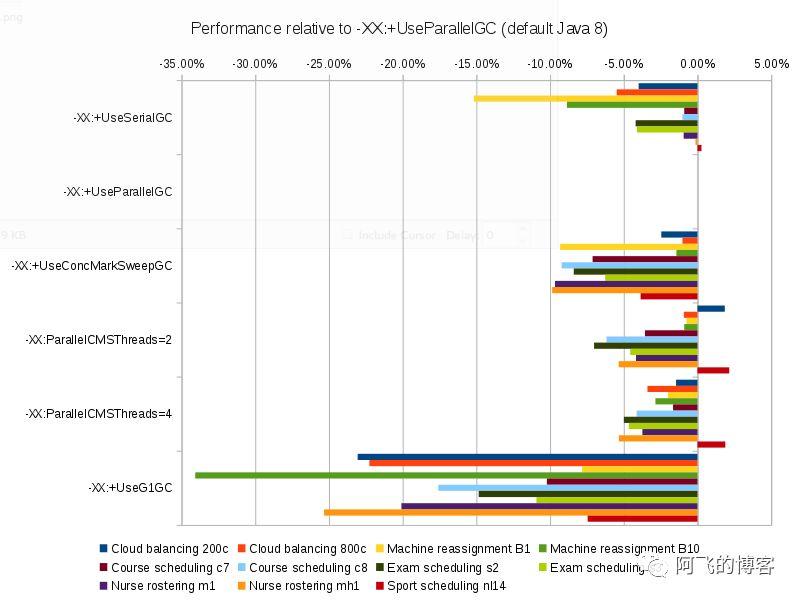jvm - gc
CMS GC, the full collection is serial and STW,
CMS GC、Parallel Old GC、G1
Young generation collectors
Copy (enabled with -XX:+UseSerialGC)
the serial copy collector, uses one thread to copy surviving objects from Eden to Survivor spaces and between Survivor spaces until it decides they've been there long enough, at which point it copies them into the old generation.
PS Scavenge (enabled with -XX:+UseParallelGC)
the parallel scavenge collector, like the Copy collector, but uses multiple threads in parallel and has some knowledge of how the old generation is collected (essentially written to work with the serial and PS old gen collectors).
ParNew (enabled with -XX:+UseParNewGC)
the parallel copy collector, like the Copy collector, but uses multiple threads in parallel and has an internal 'callback' that allows an old generation collector to operate on the objects it collects (really written to work with the concurrent collector).
G1 Young Generation (enabled with -XX:+UseG1GC)
the garbage first collector, uses the 'Garbage First' algorithm which splits up the heap into lots of smaller spaces, but these are still separated into Eden and Survivor spaces in the young generation for G1.
Old generation collectors
MarkSweepCompact (enabled with -XX:+UseSerialGC)
the serial mark-sweep collector, the daddy of them all, uses a serial (one thread) full mark-sweep garbage collection algorithm, with optional compaction.
PS MarkSweep (enabled with -XX:+UseParallelOldGC)
the parallel scavenge mark-sweep collector, parallelised version (i.e. uses multiple threads) of the MarkSweepCompact.
ConcurrentMarkSweep (enabled with -XX:+UseConcMarkSweepGC)
the concurrent collector, a garbage collection algorithm that attempts to do most of the garbage collection work in the background without stopping application threads while it works (there are still phases where it has to stop application threads, but these phases are attempted to be kept to a minimum). Note if the concurrent collector fails to keep up with the garbage, it fails over to the serial MarkSweepCompact collector for (just) the next GC.
G1 Mixed Generation (enabled with -XX:+UseG1GC)
the garbage first collector, uses the 'Garbage First' algorithm which splits up the heap into lots of smaller spaces.
I drew this diagram on a white board for some customers recently. They seemed to
like it (or were just being very polite) so I thought I redraw it for your
amusement.

Each blue box represents a collector that is used to collect a generation. The
young generation is collected by the blue boxes in the yellow region and
the tenured generation is collected by the blue boxes in the gray region.
- "Serial" is a stop-the-world, copying collector which uses a single GC thread.
- "ParNew" is a stop-the-world, copying collector which uses multiple GC threads. It differs from "Parallel Scavenge" in that it has enhancements that make it usable with CMS. For example, "ParNew" does the synchronization needed so that it can run during the concurrent phases of CMS.
- "Parallel Scavenge" is a stop-the-world, copying collector which uses multiple GC threads.
- "Serial Old" is a stop-the-world, mark-sweep-compact collector that uses a single GC thread.
- "CMS" is a mostly concurrent, low-pause collector.
- "Parallel Old" is a compacting collector that uses multiple GC threads.
Using the -XX flags for our collectors for jdk6,
-
UseSerialGC is "Serial" + "Serial Old"
- UseParNewGC is "ParNew" + "Serial Old"
- UseConcMarkSweepGC is "ParNew" + "CMS" + "Serial Old". "CMS" is used most of the time to collect the tenured generation. "Serial Old" is used when a concurrent mode failure occurs.
UseParallelGC is "Parallel Scavenge" + "Serial Old"
UseParallelOldGC is "Parallel Scavenge" + "Parallel Old"
FAQ
1) UseParNew and UseParallelGC both collect the young generation using
multiple GC threads. Which is faster?
There's no one correct answer for this questions. Mostly they perform equally well, but I've seen one
do better than the other in different situations. If you want to use
GC ergonomics, it is only supported by UseParallelGC (and UseParallelOldGC)
so that's what you'll have to use.
2) Why doesn't "ParNew" and "Parallel Old" work together?
"ParNew" is written in
a style where each generation being collected offers certain interfaces for its
collection. For example, "ParNew" (and "Serial") implements
space_iterate() which will apply an operation to every object
in the young generation. When collecting the tenured generation with
either "CMS" or "Serial Old", the GC can use space_iterate() to
do some work on the objects in the young generation.
This makes the mix-and-match of collectors work but adds some burden
to the maintenance of the collectors and to the addition of new
collectors. And the burden seems to be quadratic in the number
of collectors.
Alternatively, "Parallel Scavenge"
(at least with its initial implementation before "Parallel Old")
always knew how the tenured generation was being collected and
could call directly into the code in the "Serial Old" collector.
"Parallel Old" is not written in the "ParNew" style so matching it with
"ParNew" doesn't just happen without significant work.
By the way, we would like to match "Parallel Scavenge" only with
"Parallel Old" eventually and clean up any of the ad hoc code needed
for "Parallel Scavenge" to work with both.
Please don't think too much about the examples I used above. They
are admittedly contrived and not worth your time.
3) How do I use "CMS" with "Serial"?
-XX:+UseConcMarkSweepGC -XX:-UseParNewGC.
Don't use -XX:+UseConcMarkSweepGC and -XX:+UseSerialGC. Although that's seems like
a logical combination, it will result in a message saying something about
conflicting collector combinations and the JVM won't start. Sorry about that.
Our bad.
4) Is the blue box with the "?" a typo?
That box represents the new garbage collector that we're currently developing called
Garbage First or G1 for short. G1 will provide
-
More predictable GC pauses
-
Better GC ergonomics
-
Low pauses without fragmentation
-
Parallelism and concurrency in collections
-
Better heap utilization
G1 straddles the young generation - tenured generation boundary because it is
a generational collector only in the logical sense. G1 divides the
heap into regions and during a GC can collect a subset of the regions.
It is logically generational because it dynamically selects a set of
regions to act as a young generation which will then be collected at
the next GC (as the young generation would be).
The user can specify a goal for the pauses and G1
will do an estimate (based on past collections) of how many
regions can be collected in that time (the pause goal).
That set of regions is called a collection set and G1 will
collect it during the next GC.
G1 can choose the regions with the most garbage to collect first (Garbage First, get it?)
so gets the biggest bang for the collection buck.
G1 compacts so fragmentation is much less a problem. Why is it a problem at all?
There can be internal fragmentation due to partially filled regions.
The heap is not statically divided into
a young generation and a tenured generation so the problem of
an imbalance in their sizes is not there.
Along with a pause time goal the user can specify a goal on the fraction of
time that can be spent on GC during some period (e.g., during the next 100 seconds
don't spend more than 10 seconds collecting). For such goals (10 seconds of
GC in a 100 second period) G1 can choose a collection set that it expects it can collect in 10 seconds and schedules the collection 90 seconds (or more) from the previous collection. You can see how an evil user could specify 0 collection
time in the next century so again, this is just a goal,
not a promise.
If G1 works out as we expect, it will become our low-pause collector in place of
"ParNew" + "CMS". And if you're about to ask when will it be ready, please don't
be offended by my dead silence. It's the highest priority project for our team,
but it is software development so there are the usual unknowns. It will be out
by JDK7. The sooner the better as far as we're concerned.
Updated February 4. Yes, I can edit an already posted blog. Here's
a reference to the G1 paper if you have ACM portal access.

没有最好的垃圾回收器,只有更适合业务的垃圾回收器。如果对GC的停顿时间很敏感,那么请使用G1,比如WEB服务器;如果对吞吐量有很大的要求,建议使用ParallelGC,比如OptaPlanner这种测试用例。
- force GC
jcmd <pid> GC.run



 浙公网安备 33010602011771号
浙公网安备 33010602011771号